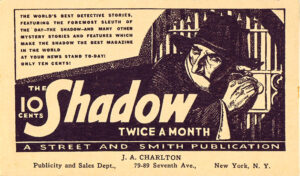 Continuing my “selling the pulps” series, this post turns our attention to postcards.
Continuing my “selling the pulps” series, this post turns our attention to postcards.
The postcards featured below were mailed out by Street & Smith Publications to magazine wholesalers (regional distributors) or vendors (the folks who actually sold pulp magazines to readers).
The postcards come from the collection of John Olsen, who writes our That’s Pulp! blog, and who also provided the scans. (Thanks, John!)
I haven’t found much — make that, any — information about these cards in my research over the past couple of months. I talked with Dwight Fuhro, who has at least one of The Shadow postcards, but he had little information, either. With that in mind, I will at least put the postcards in context.
John says the postcards are a standard penny card known as a UX27, and were sold by the U.S. Post Office Department (as it was called then) from 1914 to the early 1950s. Street & Smith more than likely bought them in bulk — John says they were sold in bundles of 100 — and printed in-house.
These cards date from 1928 through 1935. Let’s take a look at the cards, in roughly chronological order.
First up is a card touting Street’s fiction group, with a list of newsstand dates for April 1928.
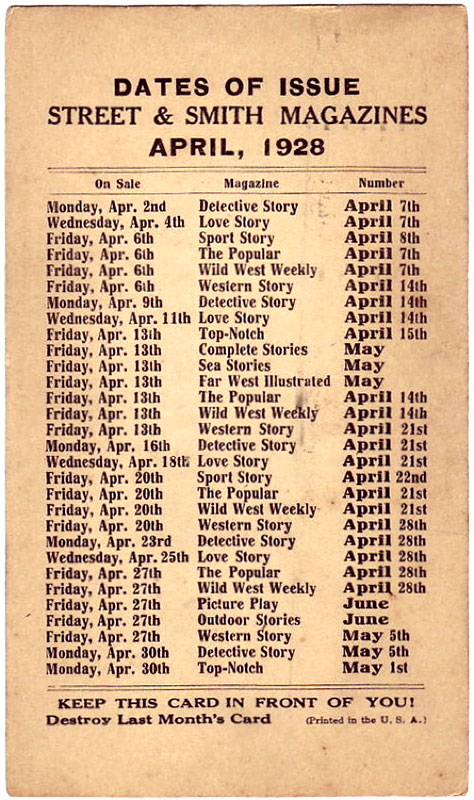
Take a look at the “Number” column. That’s the date that typically appears on the cover of a pulp magazine. It’s not the date the magazine hit the magazine rack, but the date that issue could be removed from display and returned as unsold to the publisher for credit (or in some instances, the cover or a portion of the cover was removed and sent back in lieu of shipping the entire magazine).
Curiously, after the first week of April, the gap between the “On Sale” dates and the “Number” dates is often extremely short, maybe a day or two. Most of the “Number” dates are Saturdays, with an occasional Sunday.
I’m puzzled by this. Could they actually sell enough copies during that limited window? Or was Street following a different system with cover and return dates?
Let’s skip ahead five years. In 1931, The Shadow Magazine arrived, and in 1933 it was joined at Street by two more hero pulps, Nick Carter Magazine and Doc Savage Magazine.
This postcard from Feb. 7, 1933, which was most likely dated on its arrival, encouraged wholesalers to put the new Nick Carter Magazine front and center to boost sales.
This postcard is dated Feb. 16, 1933, the day before the first number of Doc Savage Magazine was due to hit the newsstands. Both the Doc Savage and Nick Carter pulps had cover dates of March 1933.
Detective Story Magazine was the first specialized pulp magazine, with a focus on detective fiction. It debuted on a twice-a-month schedule with its Oct. 5, 1915, number. Within two years, its popularity had prompted Street to publish it weekly.
By 1932, Detective Story had been a weekly magazine for 15 years. But in September of that year, only one number was issued; then beginning in October 1932, it went twice-a-month.
When it first appeared, Detective Story was one of around two dozen pulp titles on newsstands. By 1932, it was lost among more than 120 different titles. No doubt sales had fallen because of increased competition, so Street used the postcard (above left) to remind wholesalers to push the long-running magazine on newsstands to boost sales.
At right is a postcard that also encouraged wholesalers to give extra attention to Street’s two new magazines. It’s dated March 27, 1933, shortly after the second numbers of Nick Carter Magazine and Doc Savage Magazine would have hit the newsstands.
While it’s not a pulp magazine, Street & Smith’s Picture Play (above left) gets a mention here since I featured pulp advertisements that ran in the movie-fan magazine in a couple of posts back in February.
Air Trails, which had first appeared in October 1928, went on hiatus with its October 1931 number. It returned with a new title, Bill Barnes, Air Adventurer, and a cover date of February 1934.
The postcard at right would have arrived while the first new number was still on newsstands, but a couple of weeks before the second. It shows the cover of the first number, while promoting the story in the upcoming second one.
The postcard above says it is a followup to a letter sent to wholesalers regarding the August 1934 number of Cowboy Stories. That particular number doesn’t appear to be anything special in the series. Cowboy Stories was back on the newsstands following a spotty 1932 and a seven-month hiatus in 1933. Maybe Street just wanted to give it an extra kick for summer reading.
Here’s another attempt to push up summer sales by Street, this time for its movie-fan magazine, Picture Play.
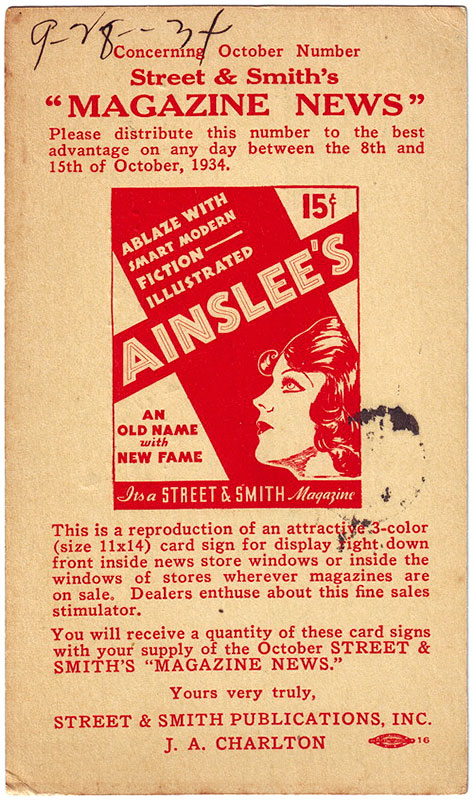 This postcard above was clearly aimed at magazine wholesalers and retailers. It promotes a display card for Street & Smith magazines, and mentions Magazine News.
This postcard above was clearly aimed at magazine wholesalers and retailers. It promotes a display card for Street & Smith magazines, and mentions Magazine News.
I haven’t been able to turn up any information on Street & Smith Magazine News, so I don’t know if it was a magazine or a newsletter. But it appears to have been a trade publication, which might have included suggestions for proper display of Street magazines, ways to increase sales, and information on the firm’s upcoming magazines.
In my previous “Selling the pulps” entry, I provided some background about Ainslee’s. The old Street magazine title was resurrected with an October 1934 number.
The postcard at right alerts dealers to a card sign to be used to promote the magazine’s debut. (As I mentioned in that previous post, the magazine ceased publication in just three years.)
Street touts the publication of the upcoming titles in its short-lived Ideal Library book series. “The Eyes of the Shadow” originally appeared as the lead novel in the second number of The Shadow Magazine in 1931. It followed the Ideal Library’s publication of the first novels for both The Shadow and Doc Savage, also in 1935.
I mentioned above that Detective Story Magazine had gone twice-monthly in 1932. By late 1935, the detective fiction magazine slowed to a monthly schedule, and its cover price increased 5 cents to 20 cents an issue.
Here’s one last postcard front. There’s no date written on it, nor any mention of a particular issue. It’s simply a promotional item for The Shadow Magazine, featuring what appears to be an interior illustration from the magazine.
It, like several others, is “signed” J.A. Charlton or John A. Charlton. There’s very little information about Charlton available online or in the references I’ve checked. But apparently he was a long-time circulation manager for newspapers and magazines. The earliest record I found shows him as circulation manager in 1907 for Sunny South Publishing Co. of Atlanta, which published Uncle Remus’s Magazine.
In 1911, Charlton was named assistant business manager and superintendent of circulation for the New York Tribune. He served in that role until sometime in 1913. By the time of these postcards, he was in a similar circulation role at Street & Smith.
You’ll notice that he is also listed as being associated with Chelsea News Co. on several of the cards. Chelsea News Co. was formed by Street & Smith in the mid-1920s when it cut ties with the American News Co., which had been distributing its publications to, according to Quentin Reynolds‘ The Fiction Factory, around 725 wholesalers and 17,000 retailers around the United States.
Chelsea News helped Street reduce costs by cutting out the middle man, in this case American News, and distributing its magazines directly to independent wholesalers, who were the recipients of these postcards.
Rounding out today’s post, I wanted to give you a look at the other side of the postcards. As mentioned at the top, the cards were standard UX27 postcards, with 1-cent postage already imprinted.
John Olsen said that all of these cards were addressed to W.C. Allison News Stand at 2 E. Choctaw Ave., McAlester, Okla. Something called Terri’s Red Barn is at that location today. It may be the same building that housed the newsstand back in the 1930s; it does look as if it could be from that era.
In 1932, McAlester had a population of just over 11,800. It also supported two newspapers (the daily McAlester News-Capital, with a circulation of 3,600, and the weekly McAlester Democrat, with a circulation of 1,300). A monthly magazine, Oklahoma Mason, with a circulation of 7,500, was also published there. Today, McAlester has a population of just over 18,300. At some point, the News-Capital and the Democrat merged to become the McAlester News-Capital & Democrat, but it is now known as just the McAlester News-Capital.
When these postcards were mailed to W.C. Allison no one would have expected them to have been kept, but someone did just that. And over 80 years later, they give us another peek at the effort that went into selling the pulps.

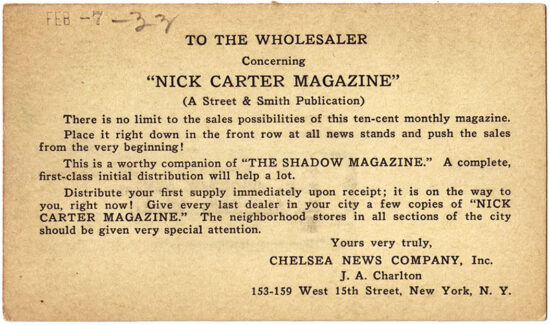
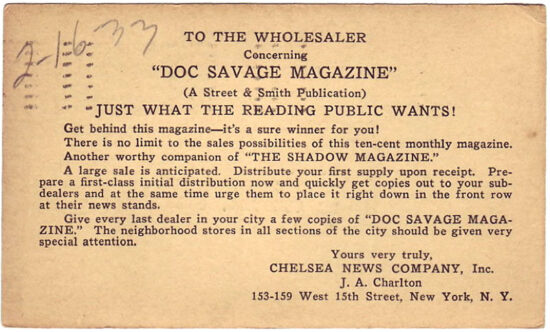
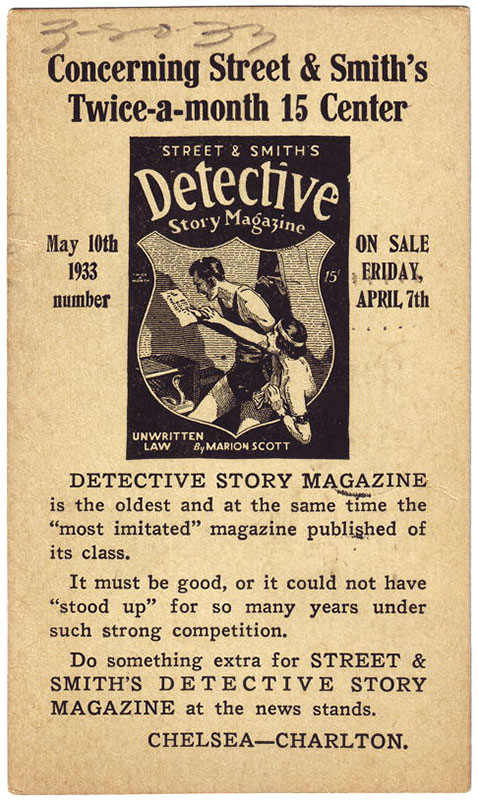
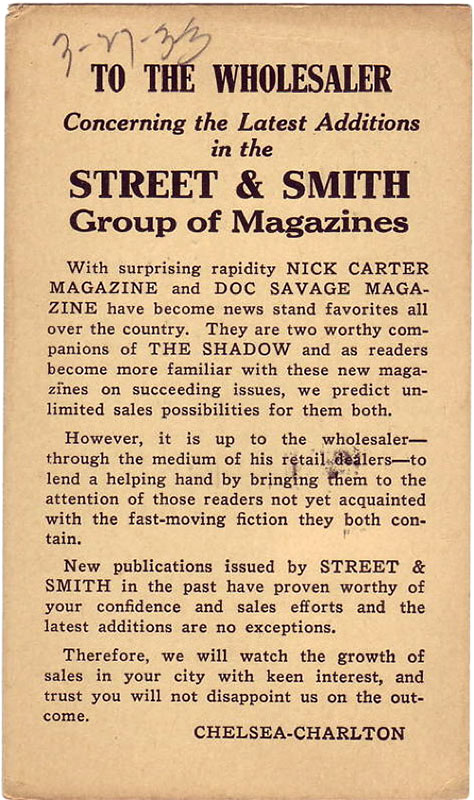
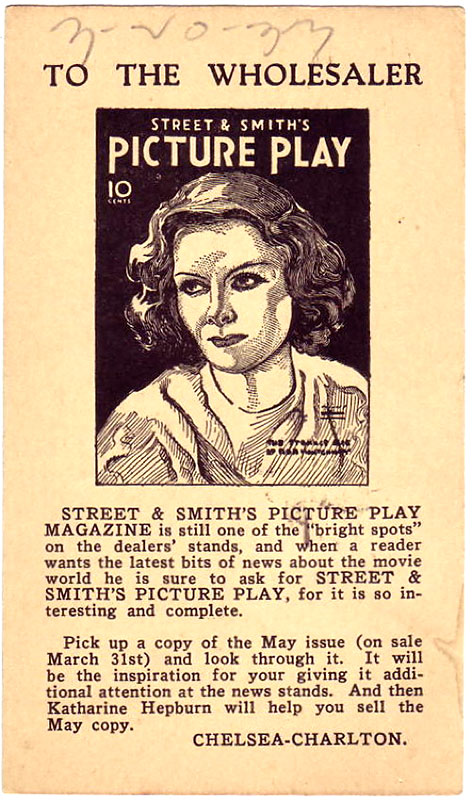
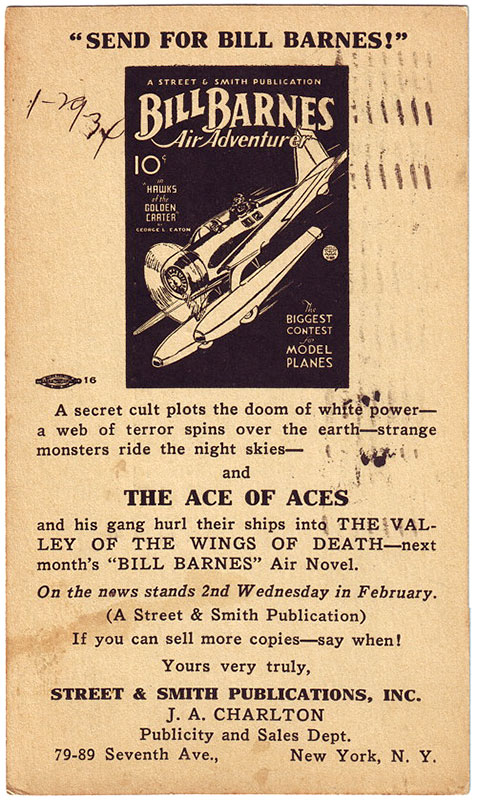
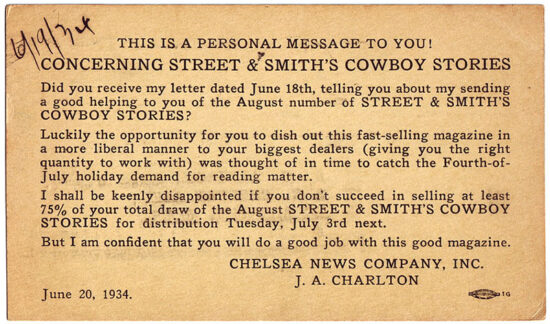

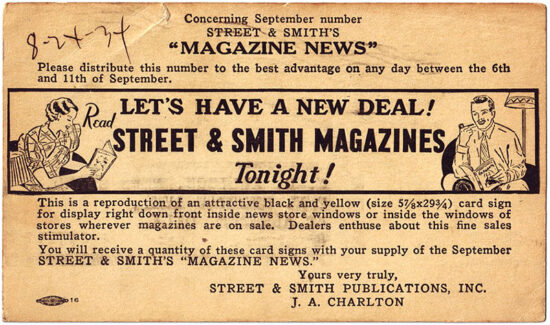
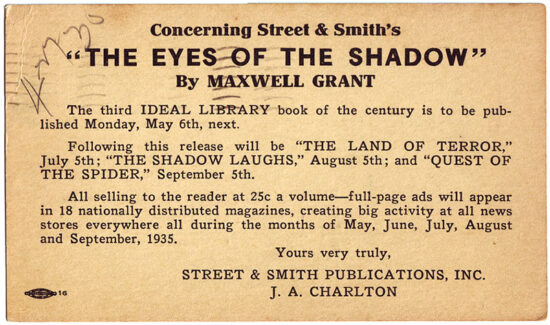
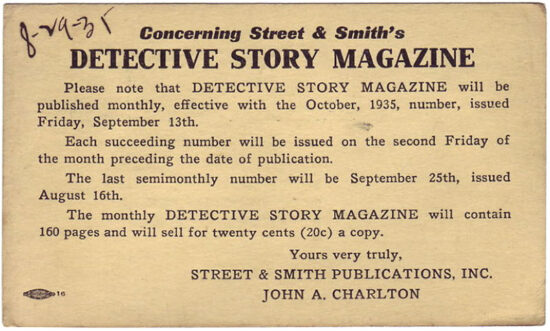
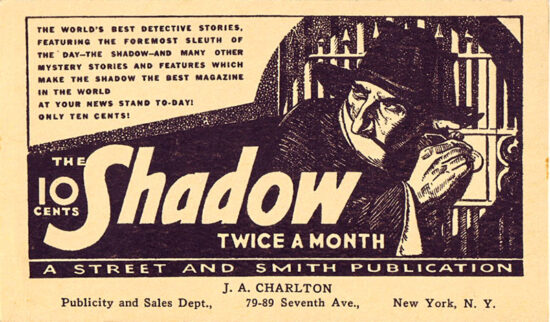
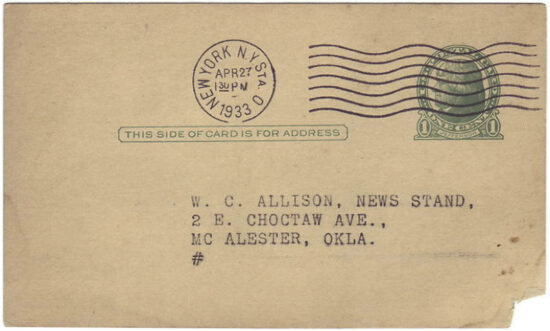

Chelsea News is kind of an interesting name. Makes me think of S&S’s book arm, Chelsea Publishing. Wonder which came first?
And when I think of Charlton, I think of Charlton Publications and Charlton Comics, which came about a few years after this,
Chelsea House, Street & Smith’s cloth-bound book publisher, started in the early 1920s, while Chelsea News came along in the mid-1920s. I can’t confirm it, but I assume the Chelsea name comes from the Chelsea area of Manhattan where Street & Smith was located.
Yeah, Charlton Publications came to my mind, too, Michael. I checked, but there is no connection. Charlton Publications’ name comes from Charles, the name of the sons of the two founders.
The Chelsea House line of books started in 1921.
Thanks, Sheila!
Very interesting stuff. Fascinating in fact.
Thanks, Barry!
I hope you find some ink blotters advertising pulps! Small ink blotters were in vogue when fountain pens were the only ones sold, and often carried advertising on their backs.
The only ink blotters that are somewhat pulp-related (that I am aware of) are the ones promoting Blue Coal, sponsor of The Shadow radio program.
Fascinating indeed! So when “wholesalers” are referred to in these postcards, are they actually distributors for certain areas?
For instance, when I worked many years at my second job decades ago, the Bus Terminal Newsstand in Coral Gables, if I remember right Ingram was the company that dropped off bundles of magazines, boxes of books. Though I don’t know how large an area they then covered.
(I see they’re still in business: http://www.ingramcontent.com/publishers/distribution/magazine)